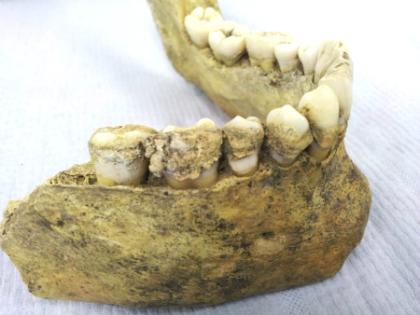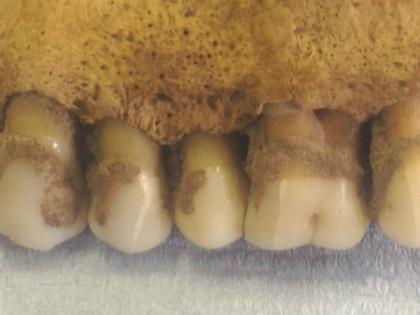Archaeologists use ancient teeth to find evidence that humans drank milk 5,000 years ago
Ben Miller
Source - http://www.culture24.org.uk/history-and-heritage/archaeology/art511374-archaeologists-use-ancient-teeth-to-find-evidence-that%20humans-drank-milk-five-thousand-years-ago
Experts carry out lab tests in three countries to confirm that Europeans drank milk 5,000 years ago

Human mandible with extensive dental calculus deposits dated to the Roman period from York (1st-4th century)© Camilla Speller
An international team of archaeologists and scientists say proteins found in the dental plaque of peasants from Roman and medieval Yorkshire provide “direct evidence” of milk consumption from as early as the Bronze Age.
Europeans could have drunk milk as long as 5,000 years ago, with cattle, sheep and goat whey found on dentures supporting isotopic results from the pottery and cooking utensils of early farming communities.
Researchers from York, Oxford, Edinburgh and London joined experts from Germany, the US, Denmark and Australia to examine the teeth of people in Yorkshire between 1000 and 1550 AD, drawing some of the strongest conclusions to date about milk, which is usually difficult to detect due to its swift disappearance from archaeological remains.
“Most of the molecular evidence for milk consumption has previously come from residues on ceramics,” says Dr Camilla Speller, from the University of York’s BioArCh research facility.
“While pot residues can tell you that people are using dairy products, it can't tell you which individuals in the group are actually consuming the milk.
“This study is very exciting because for the first time we can link milk consumption to specific skeletons and figure out who has access to this important nutritional resource."
The team used mass spectrometry-based techniques to sequence the ancient protein, beta-lactoglobulin, from the remains.
“It seemed too good to be true,” admits Jessica Hendy, a lead author on the research working in York.
“Beta-lactoglobulin is the dominant whey protein - the one used by bodybuilders to build muscle mass - and therefore the ideal marker for milk consumption.
“We kept finding sequences of beta-lactoglobulin and at first we thought it could be modern contamination.
“But we repeated the analysis several times, at three different laboratories in three different countries – each time finding the same results.”
Strong genetic mutations, noted only in certain populations, including northern Europe, allow the intenstinal enzyme which digests lactose milk sugar during infancy, lactace, to be produced throughout a lifetime.
In most other people of the world, the lactose cannot be properly digested and can cause diarrhea or other symptoms of lactose intolerance, aggravated by the gases produced by fermentation of the gut bacteria.
“The study has far-reaching implications for understanding the relationship between human diet and evolution,” says Dr Christina Warinner, from the Department of Anthropology at the University of Oklahoma.
“Dairy products are a very recent, post-Neolithic dietary innovation, and most of the world’s population is unable to digest lactose, often developing the symptoms of lactose intolerance.
“The discovery of milk proteins in human dental calculus will allow scientists to unite these lines of evidence and compare the genetic traits and cultural behaviors of specific individuals who lived thousands of years ago.”
Among the more expected findings, the team found no evidence of milk protein in the remains of 19th century individuals from West Africa, where dairying was uncommon – although “widespread” evidence of milk consumption was shown at European sites across the past 5,000 years.
The report says cows and sheep drank milk during the Bronze Age, although goats only did so in northern Italy.

Milk proteins were detected in the dental calculus of British medieval peasants in Yorkshire (1000-1550 CE)© Camilla Speller